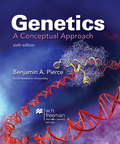
To examine:
The cross between black and bronze plumage.
Introduction:
Plumage refers to the colored pattern or the layer of father that cover a bird, including the arrangement of the feathers. In different species or subspecies of birds the pattern and color of plumage are varied. The colors of plumage include black and bronze. The alleles for the black color is
Explanation of Solution
A cross between the
A cross between
To examine:
The cross between black and black plumage.
Introduction:
The colors of plumage include black and bronze. The alleles for the black color is
Explanation of Solution
A cross between the
The obtained genotypic ratio is 3:1.
The obtained phenotypic ratio is 3:1.
A cross between
To examine:
The cross between black-bronze and black-bronze plumage.
Introduction:
The allele for the bronze color is
Explanation of Solution
A cross between the
A cross between
To examine:
The cross between black and-bronze color plumage.
Introduction:
Plumage is the layer of feathers with different colored patterns that cover a bird, including the arrangement of the feathers. The alleles for the black color is
Explanation of Solution
A cross between the
The obtained genotypic ratio is 1:1:1:1
The obtained phenotypic ratio is 1:2:1 (bronze:black:black-bronze)
A cross between
To examine: The cross between bronze and-black-bronze plumage.
Introduction:
In different species or subspecies of birds the pattern and color of plumage are varied. The colors of plumage include black and bronze. The alleles for the black color is
Explanation of Solution
A cross between the
The obtained genotypic ratio is 1:1
The obtained phenotypic ratio is 1:1 (bronze : black-bronze)
A cross between
To examine:
The cross between bronze and bronze plumage.
Introduction:
The colors of plumage include black and bronze. The alleles for the black color is
Explanation of Solution
A cross between the
The obtained genotypic ratio is 1:2:1
The obtained phenotypic ratio is 3:1 (bronze : black-bronze)
A cross between
To explain:
Whether these differences in plumage arise from incomplete dominance or not.
Introduction:
When one of the paired alleles does not completely express itself for a particular
Explanation of Solution
Incomplete dominance is the phenomenon in which one of the alleles for specific phenotype is not completely expressed. These differences in plumage arise from the incomplete dominance because the allele for the bronze color (
Symbols for alleles:
Genotype of turkeys:
Cross 1:
Cross 2:
Cross 3:
Cross 4:
Cross 5:
Cross 6:
Hence, the result of cross 1 shows that all plumages are of black color. The result of cross 2 shows that black is dominant over bronze color in the ratio of 3:1. The result of cross 3 shows that all plumages are of black-brown color. The result of cross 4 shows that ½ offspring are black, ¼ offspring are bronze, and ¼ offspring are black-bronze. The result of the cross 5 shows that half of the offsprings are bronze and half are black bronze. The result of cross 6 shows that ¾ offspring is bronze and ¼ fourth are black-bronze.
Want to see more full solutions like this?
Chapter 5 Solutions
Genetics: A Conceptual Approach
- Can you described the image? Can you explain the question as well their answer and how to get to an answer to an problem like this?arrow_forwardglg 112 mid unit assignment Identifying melting processesarrow_forwardGive only the mode of inheritance consistent with all three pedigrees and only two reasons that support this, nothing more, (it shouldn't take too long)arrow_forward
- Oarrow_forwardDescribe the principle of homeostasis.arrow_forwardExplain how the hormones of the glands listed below travel around the body to target organs and tissues : Pituitary gland Hypothalamus Thyroid Parathyroid Adrenal Pineal Pancreas(islets of langerhans) Gonads (testes and ovaries) Placentaarrow_forward
- What are the functions of the hormones produced in the glands listed below: Pituitary gland Hypothalamus Thyroid Parathyroid Adrenal Pineal Pancreas(islets of langerhans) Gonads (testes and ovaries) Placentaarrow_forwardDescribe the hormones produced in the glands listed below: Pituitary gland Hypothalamus Thyroid Parathyroid Adrenal Pineal Pancreas(islets of langerhans) Gonads (testes and ovaries) Placentaarrow_forwardPlease help me calculate drug dosage from the following information: Patient weight: 35 pounds, so 15.9 kilograms (got this by dividing 35 pounds by 2.2 kilograms) Drug dose: 0.05mg/kg Drug concentration: 2mg/mLarrow_forward
- A 25-year-old woman presents to the emergency department with a 2-day history of fever, chills, severe headache, and confusion. She recently returned from a trip to sub-Saharan Africa, where she did not take malaria prophylaxis. On examination, she is febrile (39.8°C/103.6°F) and hypotensive. Laboratory studies reveal hemoglobin of 8.0 g/dL, platelet count of 50,000/μL, and evidence of hemoglobinuria. A peripheral blood smear shows ring forms and banana-shaped gametocytes. Which of the following Plasmodium species is most likely responsible for her severe symptoms? A. Plasmodium vivax B. Plasmodium ovale C. Plasmodium malariae D. Plasmodium falciparumarrow_forwardStandard Concentration (caffeine) mg/L Absorbance Reading 10 0.322 20 0.697 40 1.535 60 2.520 80 3.100arrow_forwardPlease draw in the missing answer, thank youarrow_forward
 Human Anatomy & Physiology (11th Edition)BiologyISBN:9780134580999Author:Elaine N. Marieb, Katja N. HoehnPublisher:PEARSON
Human Anatomy & Physiology (11th Edition)BiologyISBN:9780134580999Author:Elaine N. Marieb, Katja N. HoehnPublisher:PEARSON Biology 2eBiologyISBN:9781947172517Author:Matthew Douglas, Jung Choi, Mary Ann ClarkPublisher:OpenStax
Biology 2eBiologyISBN:9781947172517Author:Matthew Douglas, Jung Choi, Mary Ann ClarkPublisher:OpenStax Anatomy & PhysiologyBiologyISBN:9781259398629Author:McKinley, Michael P., O'loughlin, Valerie Dean, Bidle, Theresa StouterPublisher:Mcgraw Hill Education,
Anatomy & PhysiologyBiologyISBN:9781259398629Author:McKinley, Michael P., O'loughlin, Valerie Dean, Bidle, Theresa StouterPublisher:Mcgraw Hill Education, Molecular Biology of the Cell (Sixth Edition)BiologyISBN:9780815344322Author:Bruce Alberts, Alexander D. Johnson, Julian Lewis, David Morgan, Martin Raff, Keith Roberts, Peter WalterPublisher:W. W. Norton & Company
Molecular Biology of the Cell (Sixth Edition)BiologyISBN:9780815344322Author:Bruce Alberts, Alexander D. Johnson, Julian Lewis, David Morgan, Martin Raff, Keith Roberts, Peter WalterPublisher:W. W. Norton & Company Laboratory Manual For Human Anatomy & PhysiologyBiologyISBN:9781260159363Author:Martin, Terry R., Prentice-craver, CynthiaPublisher:McGraw-Hill Publishing Co.
Laboratory Manual For Human Anatomy & PhysiologyBiologyISBN:9781260159363Author:Martin, Terry R., Prentice-craver, CynthiaPublisher:McGraw-Hill Publishing Co. Inquiry Into Life (16th Edition)BiologyISBN:9781260231700Author:Sylvia S. Mader, Michael WindelspechtPublisher:McGraw Hill Education
Inquiry Into Life (16th Edition)BiologyISBN:9781260231700Author:Sylvia S. Mader, Michael WindelspechtPublisher:McGraw Hill Education





